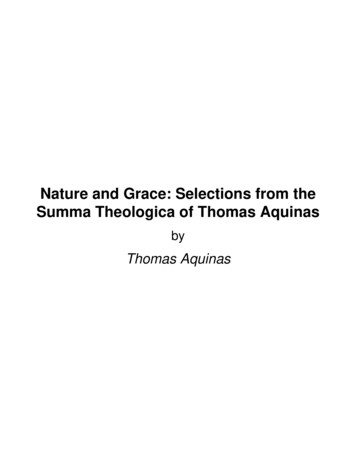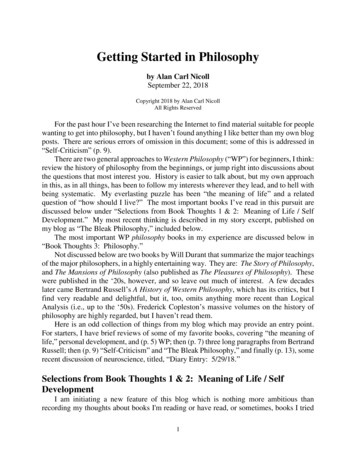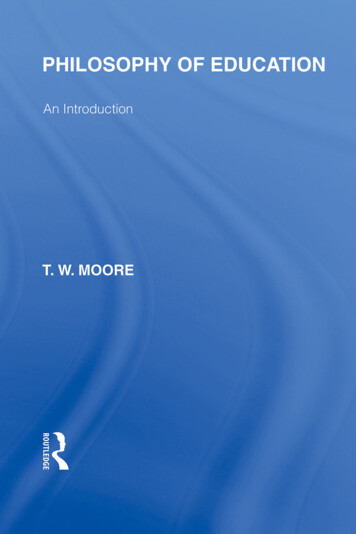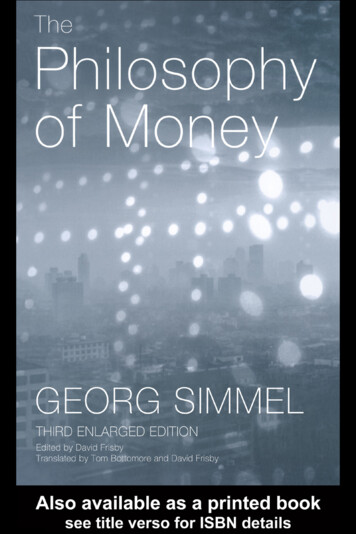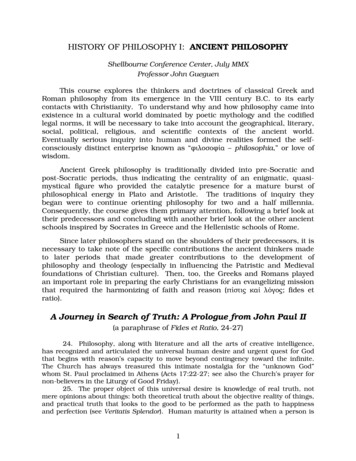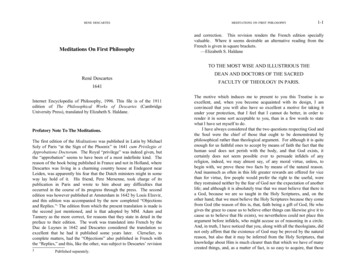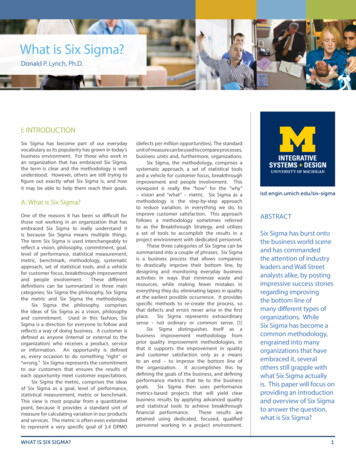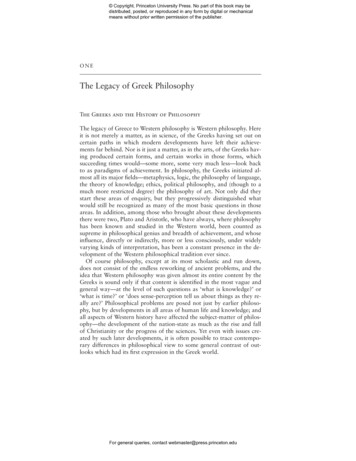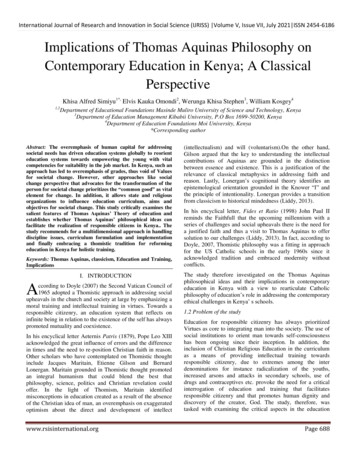
Transcription
International Journal of Research and Innovation in Social Science (IJRISS) Volume V, Issue VII, July 2021 ISSN 2454-6186Implications of Thomas Aquinas Philosophy onContemporary Education in Kenya; A ClassicalPerspectiveKhisa Alfred Simiyu1*, Elvis Kauka Omondi2, Werunga Khisa Stephen3, William Kosgey41,2Department of Educational Foundations Masinde Muliro University of Science and Technology, Kenya3Department of Education Management Kibabii University, P.O Box 1699-50200, Kenya4Department of Education Foundations Moi University, Kenya*Corresponding authorAbstract: The overemphasis of human capital for addressingsocietal needs has driven education systems globally to reorienteducation systems towards empowering the young with vitalcompetencies for suitability in the job market. In Kenya, such anapproach has led to overemphasis of grades, thus void of Valuesfor societal change. However, other approaches like socialchange perspective that advocates for the transformation of theperson for societal change prioritizes the “common good” as vitalelement for change. In addition, it allows state and religiousorganizations to influence education curriculum, aims andobjectives for societal change. This study critically examines thesalient features of Thomas Aquinas’ Theory of education andestablishes whether Thomas Aquinas’ philosophical ideas canfacilitate the realization of responsible citizens in Kenya. Thestudy recommends for a multidimensional approach in handlingdiscipline issues, curriculum formulation and implementationand finally embracing a thomistic tradition for reformingeducation in Kenya for holistic training.Keywords: Thomas Aquinas, classicism, Education and Training,ImplicationsI. INTRODUCTIONAccording to Doyle (2007) the Second Vatican Council of1965 adopted a Thomistic approach in addressing socialupheavals in the church and society at large by emphasizing amoral training and intellectual training in virtues. Towards aresponsible citizenry, an education system that reflects oninfinite being in relation to the existence of the self has alwayspromoted mutuality and coexistence.In his encyclical letter Aeternis Patris (1879), Pope Leo XIIIacknowledged the great influence of errors and the differencein times and the need to re-position Christian faith in reason.Other scholars who have contemplated on Thomistic thoughtinclude Jacques Maritain, Etienne Gilson and BernardLonergan. Maritain grounded in Thomistic thought promotedan integral humanism that could blend the best thatphilosophy, science, politics and Christian revelation couldoffer. In the light of Thomism, Maritain identifiedmisconceptions in education created as a result of the absenceof the Christian idea of man, an overemphasis on exaggeratedoptimism about the direct and development of ) and will (voluntarism).On the other hand,Gilson argued that the key to understanding the intellectualcontributions of Aquinas are grounded in the distinctionbetween essence and existence. This is a justification of therelevance of classical metaphysics in addressing faith andreason. Lastly, Lonergan’s cognitional theory identifies anepistemological orientation grounded in the Knower “I” andthe principle of intentionality. Lonergan provides a transitionfrom classicism to historical mindedness (Liddy, 2013).In his encyclical letter, Fides et Ratio (1998) John Paul IIreminds the Faithfull that the upcoming millennium with aseries of challenges and social upheavals there is the need fora justified faith and thus a visit to Thomas Aquinas to offersolution to our challenges (Liddy, 2013). In fact, according toDoyle, 2007, Thomistic philosophy was a fitting in approachfor the US Catholic schools in the early 1960s since itacknowledged tradition and embraced modernity withoutconflicts.The study therefore investigated on the Thomas Aquinasphilosophical ideas and their implications in contemporaryeducation in Kenya with a view to rearticulate Catholicphilosophy of education’s role in addressing the contemporaryethical challenges in Kenya’ s schools.1.2 Problem of the studyEducation for responsible citizenry has always prioritizedVirtues as core to integrating man into the society. The use ofsocial institutions to orient man towards self-consciousnesshas been ongoing since their inception. In addition, theinclusion of Christian Religious Education in the curriculumas a means of providing intellectual training towardsresponsible citizenry, due to extremes among the interdenominations for instance radicalization of the youths,increased arsons and attacks in secondary schools, use ofdrugs and contraceptives etc. provoke the need for a criticalinterrogation of education and training that facilitatesresponsible citizenry and that promotes human dignity anddiscovery of the creator, God. The study, therefore, wastasked with examining the critical aspects in the educationPage 688
International Journal of Research and Innovation in Social Science (IJRISS) Volume V, Issue VII, July 2021 ISSN 2454-6186theory of Thomas Aquinas, and how it has been integrated inthe Kenya’s education system towards addressing societalevils towards responsible citizenry.1.3 Research objectives: The study is tasked to:a.b.Critically examine salient features of ThomisticphilosophyEstablish whether Thomas Aquinas’ educationTheory can facilitate realization of Responsiblecitizens in Kenya1.4 MethodologyThis study adopts the analytic method whose major task is tobreakdown complex entities and tries to unfold the clarity ofthe whole and the functions of the parts (Kauka, 2018).Philosophical analysis is purely a rational and abstractmethod, thus qualitative literature was accessed to facilitatethe research as opposed to empirical research that demandsquantitative analysis. The method fits this study because it’s apurely a philosophical research.II. THEORETICAL FRAMEWORK2.1 Dialectical materialismThis embraces human capital orientation that treats man as acontinuous challenge in the society as investigated by thescientific fields (Bugiulescu, 2018). This theory is also knownas Marxist theory because it was proposed by Karl Marx(Kiruki, 2004). The understanding of the society according toMarxists is that in the society there is competition for materialresources and wealth as the main cause of conflict. The socialclasses emanating from possession of property createsantagonism between them, one of which becomes thedominant class called the bourgeoisie. The bourgeoisiecontrols both the means of material production and the ideasof the epoch. In essence state machinery, state ideology andeven religion are used to maintain the status quo. (Kiruki,2004) The revolution brought as a result of class strugglesalways elevates the bourgeoisie as the victors thus making theproletariat more vulnerable and in need of the jobs. Despiteman being a social being as described by Aristotle, his rationalfaculties when empowered can contemplate the reality as suchand thus orient man towards freedom, consciousness andholistic growth (Bugiulescu, 2018).2.2 Moral virtue TheoryGrounded in a philosophical tradition, the theory treats man asa rational, conscious, free being and created by God to knowand serve him eternally. Thus, by nature man is religious andis tuned towards the infinite being (Stoker, 2000).The churchas a moral agent is an indispensable organ that human beingsrealize the friendship and dependence on the infinite being.The overdependence on science and self-limits man inrealizing the potentials of the infinite Being. Thus, through theperson of Christ, the second person of the Trinity all humanityhas been perfected for eternity (Bugiulescu, 2018) andwww.rsisinternational.orgtherefore sanctified for the kingdom of God. Through rationalfaculties human beings are able to work for the good and beGood by the grace given unto them. This theory heavily relieson character formation and training through PupilIII. THOMAS AQUINASThomas was born in Aquino from a noble family withrelations with the royals like kings of Aragón. At the age offourteen, he became a student of the liberal arts at the imperialstudium generale in Naples, a school that later became part ofthe University of Bologna, which has commonly been viewedas the oldest secular university in Europe. Thomas being anavid scholar of the antiquity,was greatly influenced by theworks of Aristotle, Averroes and Avicenna (Jānis, 2020)Thomas Aquinas became profoundly engaged in the heateddebate about whether and how the metaphysical, ethical,psychological, and natural scientific writings of Aristotle thathad been recovered during the twelfth and thirteenth centuriesshould be integrated in the curriculum and what implicationscould they bring in reformation process (Brock,2015).According to Kiruki (2004) the Dominican AlbertusMagnus of Cologne, had a particular influence on ThomasAquinas’s views in this regard and that is why Philosophywas thus conceptualized as handmaid of Theology and equallythe state to the church in matters of the infinite (Brock, 2015).According to Brock (2015), Thomas Aquinas was anexemplary author who is alleged dictated to three sectaries ata go. He prepared a commentary on the Sentences of PeterLombard (1252-1256), Compedium Theologiae 1273, SummaContra Gentiles (1259-1264), Summa Thelogiae (1265-1273),commentaries on the works of Aristotle and other renownphilosophers and on books of the Holy Bible, Treatises,Translations, lectures, debates, sermons, hymns, poems on awide range of philosophical and theological themes.3.1 Thomas Aquinas Philosophy3.1.1 Classical MetaphysicsAs already mentioned, Thomas Aquinas was greatlyinfluenced by Aristotelian metaphysics. It has also beenremarked by contemporary scholars that if Augustine was thePlato of the Middle Ages, then Thomas Aquinas is theAristotle (Kiruki, 2004). In this section therefore, theprinciples of act and potency, entity and essence, principle ofparticipation shall be analyzed.1. Act and potencyIn chapter iv of entity and Essence Thomas clearly defines actas a form without matter and this form varies in separatesubstance. Pure actuality is only a character of the SupremeBeing whereas the intelligences have form but since they canbe caused (created) their act is not pure. Finally the matter andform in the corporeal beings makes them composite andbecause of matter being an individuation principle their existthe idea of plurality thus need for species and genus and thusdifference.Page 689
International Journal of Research and Innovation in Social Science (IJRISS) Volume V, Issue VII, July 2021 ISSN 2454-6186In the process of becoming, an item or an object shows twostates of being. One that shows the possibility of becoming(potentiality) and another attained state of being (actuality)(Collins, 1990). In addition, an object can’t have the twostates at the same time since this is against the principle ofnon contradiction. Act therefore signifies a perfection that isinhered within being, thus no limitations or no error,difference or multiplicity and on the other hand potency maybe described as a relative state of non being (Aquinas T. , ATranslation by Robert T.Miller On Being and Essence(1997)).The real distinction between act and potency is not adistinction of separate entities but of two principles of thesame reality. Thus Thomas Aquinas uses this principle individing real being with respect to perfection. According toThomas Aquinas, God “IS” a pure actuality, no potency inHim, angels are actualities, human being is in a mixedpotency and a mixed actuality whereas universe and rockshave pure potency with a limiting principle itself inhered inthem. Thus act and potency give the degree of being in thehierarchy of existence (Aquinas T. , A Translation by RobertT.Miller On Being and Essence(1997))3.1.1.2 Essence and ExistenceAristotle’s hylemorphism laid the foundation of explaining theessence and existence of beings.Hylemorphism is a theory ofact and potency that is applied to specific order of essencesand the term etymologically its derived from the Greek wordsfor matter (hyle) and form (morphe) (Kiruki, 2004).Essence isthe whatness or the form of being whereas the existence ofbeing refers to the act of being. In search for the subject ofdiscussion, Thomas Aquinas identifies essence and existenceto be the same thing in God (Aquinas T. , A Translation byRobert T.Miller On Being and Essence(1997)).In the Entity and Essence, Thomas highlights the ways inwhich the essences vary in the separate substances. God beinga perfection that ever existed, the substance of God is hisessence and it is the existence itself. For the createdintelligences, since their essences are without matter andexistence is received or caused, they are finite beings. Thusexistence and essence differ in finite beings. For the humanbeing, the existence and essence are separate entities due tothe separate relationship between matter and form, body andspirit and existence in this case is individuated by the body.3.1.1.3 CausalityDiscussion on the concept of causality in AristotelianMetaphysics, the material, formal, efficient and final causescan be traced to the process of becoming of an object.However, there has to be the cause of all causes “unmovedmover” in Aristotle’s own terms. According to Kiruki (2004),the notion of the unmoved mover had great influence on allmedieval philosophers. Since God was the pure actuality andthe cause of all creation, his existence and essence is one andthe same thing (Aquinas.T 1247-)-God can cause theexistence of intelligible and man. The plurality that therewww.rsisinternational.orgexists among the intelligible and man is as a result of thefinitude that their substances have.Man possesses rationality that allows active and passiveintellect to create and recreate and this allows man toparticipate in the causality of God as a second efficient causeof potency being moved in act. Thomas Aquinas treated manas a synthesis and placed him noble above all creation becauseof the intellect that makes him reflect on the source of allbeings, God (Bugiulescu, 2018).3.1.2 Classical EpistemologyMan as a rational being and able to reflect on the deity,Thomas Aquinas views the human intellect void of innateideas but with a potentiality of receiving concepts The humanintellect thus through the passive intellect sense knowledge isavailed and by use of the active intellect the universal isabstracted from the particulars. The human mind thus has theability to abstract concepts from the existing or known itemsand thus relate them and form new concepts. And since thereexists different items or objects due to the principle ofindividuation, the plurality of items creates the need classifythem under species and genus and thus why the mind canretain the differences and commonness of objects.The process of knowing therefore originates from theimpressions that are availed through senses. The senseperception availed to the mind enables a rational soul toabstract intelligible species from the sensible objects.However, immaterial things which are not objects ofsensation, human intellect is does not and cannot by its ownability apprehend God and spirit directly because of lack ofpositive content about them. The only way we come to knowthem is through the negative way (Via negative) thus throughdenial of the characteristics well known to sensible objects orby analogy (summa 1a,84,7).According to Thomas Aquinas, there are two major ways ofcoming to know. First and foremost Discovery: A method thatdisposes human reason by itself to reach knowledge ofunknown things and grasping their essences. Secondly,Learning by instructions: This method demands for the secondparty that is vast in the known elements that are not yetrevealed to the pupil and thus with the aid of the Teacher, thepupil is introduced, guided and ignited in his own way to userational faculties to grasp the essences of tings being taught(Aquinas T. , Truth Translated by R. W. Mulligan. 3 vols.Chicago: Regnery, 1952).3.1.3 Classical EthicsThe pagan belief and medieval approach to reality was fadingaway with the upcoming of the Faith and reason trend.Thomas Aquinas age is scholastic because of such legacy ofadvocating intellectual formation that directed all spheres oflife. Thomas in orienting man towards the ideal, intellectualformation is key and must be directed towards the Good, whois God Summa Contra Gentiles 114-138 x libros ethicorunquestions Disputetea de malo).Page 690
International Journal of Research and Innovation in Social Science (IJRISS) Volume V, Issue VII, July 2021 ISSN 2454-6186Moral soundness thus was only possible when man had toorient his voluntary actions towards knowing God and seekingthe common good. Thus Thomas Aquinas views the moralgood and evil in terms of accord and discord to divine law asrevealed in scriptures and interpreted in the Christiantradition.Thomas Aquinas ethical theory is classified byscholars as natural law theory (Kiruki, 2004).Basing on theNicomachean Ethics of Aristotle, he developed aEudaemonological and teleological standpoint in the analysisof human conduct and acquisition of virtues. All humanbeings are wired naturally to adhere to the law (Kiruki, 2004).Human being a rational being was given the conscience whichis a tool for use in deciding to execute or not execute acts.According to Thomas Aquinas, there exist Voluntary acts andinvoluntary actions. Man by his rationality has the ability tochose from a series of options guided by the intellect and for avoluntary action to be performed, there must be sufficientknowledge about the act generating the good or contributingto the attainment of the common good (Bunum Commune)Summa Theologica I-II 90, A.4c.3.1.3.1 Thomas on VirtuesAccording to Thomas virtue is a perfection of power that findsits justification in an action. Human being by nature engagingrational powers they usually determine actions and because ofthe finitude nature, human rational powers are indeterminateto act in a uni- directional way thus a series of acts areexperienced. Through habitual training thus rational powerscan be oriented towards a uniformed mode of action (SummaTheologica Ia-IIae, Q. 55, A. 1, c).Virtues being mere dispositions to act in accordance to aparticular, stable and adequate manner are modifications ofpersonality and thus can be acquired through habitualtraining.This thomistic view is in line with the Aristotelianethical notion. In the light of the training in virtues, there arefive intellectual virtues where three are speculative and twoare practical. The speculative ones are: understanding, Scienceand Wisdom (Summa Theologica Ia-IIae, Q. 57, A. 2, c).The practical Virtues are acquired when reason is rightlyapplied in doing things and executing actions. In other words,In order to do good, there is need by the human person toperfect the intellect in recognizing the truth (prudence)(Summa Theologica Ia-IIae, Q.57, A.4) and a perfection of thewill seeking good (justice–Summa Theologica Ia-IIae, Q 58A.3). Another necessary condition for doing good is thecapacity for reasonable management of emotions so that, onthe one hand, a person in a difficult situation is notoverwhelmed by the desire of sensual pleasures by practicingtemperance– Summa Theologica Ia-IIae, Q 141) and on theother hand, does not refrain from difficult challenges,especially when the journey towards the good involvessuffering (fortitude– Summa Theologica Ia-IIae, Q 123).Finally, Thomas talks of another type of virtue that are Godgiven through grace: Theological virtues. First and foremostwww.rsisinternational.orgFaith in God (Summa Theologica Ia-IIae, Q 4 A. 4), Hope(Summa Theologica Ia-IIae, Q17 A.5), and charity (SummaTheologica Ia-IIae, Q 23.A.4).3.1.3.2 Thomas on ReligionReligion has been a term during our time ignited varied viewsand tensions towards a smooth existence and raising of theyoung in virtue. In the light of Thomas Aquinas SummaTheologica, religion is elaborated as an element that is notequated to sanctity or the divine itself. According toThomas,since the time of Cicero etymologically man has beensaid to be religious ab initio from “religio” because he oftenponders over or “religit” reads again the things that pertain tothe worship of God (Summa Theologica Ia-IIae, Q 80.A.2).Religion thus objectively directs man to the sole worship ofGod alone and the main acts include adoration and sacrifice tothe supreme being any other external acts are secondary andnot immediate in the worship of God (Summa Theologica IaIIae, Q 80.A.7.)IV. CATHOLIC CHURCH AND EDUCATION IN KENYAKenya as country adopted the 8.4.4 education system in 1989for preparing a self-sufficient, responsible citizen. This ishighlighted in the national goals of education by the KenyaInstitute of Education syllabuses (Kenya Institute ofEducation (KIE) , 2013). Scholars have criticized the processof change of education systems in Kenya to be void ofconsultative process and need based on societal issues(Muricho,P.,& Chang'ach,J., 2013). Political interests havetaken over the entire education process and thus limiting anyother social institution to influence education process(Amutabi, 2003).However, the philosophical, rational andconscious roots of man are always grounded on a religiousfooting (Mbithi, 1988), (Fatih, 2018) Thus by nature man hasto discover the divine being.Based on the Ideal of Thomas Aquinas on the possibility ofthe human being to be taught as presented in his Treatise DeMagistro, the early missionaries developed centres for thetraining of teachers with a sound moral shaped around theimitation of Christ the model teacher of the Gospel. Thus theteacher was to orient the pupils towards the knowledge ofGod. As a cause of Knowledge, The teacher was to beprepared in the Christ centered training to facilitate learning.Secondly, Discipline has been emphasized by the catholictradition, for the learner to acquire true knowledge Virtues areto be acquired and practiced frequently. Prudence, justice,temperance and fortitude have taken the lead during thepandemic where the church has championed giving of alms,donations, volunteer service providers to refugee camps andregions hit by disasters i.e. floods, hunger etc. These practiceshave provided room for the church to affirm the presence ofGod in the suffering people. Thus, catholic institutions haveprovided both material and non-material items towards theneedy and thus building a common body of Christ.Page 691
International Journal of Research and Innovation in Social Science (IJRISS) Volume V, Issue VII, July 2021 ISSN 2454-6186Thirdly, the pastoral programmes have been opportunities forthe young to discover the infinite, learn to read andcontemplate the scripture in order to shape character in thelearning environment. Morning and evening services, HolyMass offered with specific intentions for the students hasalways introduced learners to a pious lifestyle towards theTranscendent Being.option of making the decision was offered to him. ThomasAquinas closely links this topic to the Aristotelian syllogism.He stresses, for example, that the presentation of the subjectmatter to be taught must be logical, precise, and lucid. Clarityis central to successful instruction. Moreover, he gives priorityto the way in which the teacher presents his material, whichmust be both effective and appealing to the mind.V. IMPLICATIONS THOMAS AQUINAS IDEAS TOEDUCATION AND TRAINING IN KENYAFurther recommendations include the use of a questionanswer sequence in discussing topics, the review of historicsolutions of problems, the use of symbols as tools forinstruction in particularly unfamiliar things or ideas, and thelinking up of the subject under discussion with as many othersubjects as possible. The emphasis here is on “possible,”because one should not risk confusing the student.5.1 Aims of EducationThe primary role of every student is to fall in love with themaster. Discipleship as given by Thomas demands strictadherence to divine law and precepts of the Church. Scriptureoccupies a crucial place in the life of the pupil and thus theentire education and training process facilitates the knowingand discovery of God. Secondly, with God given Potentials,the Pupil is to serve humanity as given in the Gospels. Themessage of living the scripture demands responsibility andacts of mercy and charity thus emphasis laid on individualresponsibility drives education practitioners to participate incommunity and societal development activities withoutreservations. Religion thus has external acts which model onetowards virtue and thus through habitual training students canacquire them in their schools and learning environments(Summa Theologica Ia-IIae, Q 80).With the imitation of Christ, the triumph over death at Calvarymotivates the followers of the master to endure some pain forthe sake of future joys. Character formation has always been achallenge and sometimes demands loss of friends, pains,sorrows but enduring them models one for future tragicsituations.5.2 CurriculumThe christocentric curriculum aims at orienting the wholeperson towards God the creator. Thus all activities are startedby prayer and finished by prayer. This is a reconciliatorycurriculum which gives hope to the hopeless and courage tothe downhearted.5.2.1 Curriculum contentScripture takes the centre stage of the education and trainingprocess. Christian Religious Education (CRE) is a subjectprepared to expose the student to the Old Testament and NewTestament Books. This content is geared towards achievingthe mission of orienting students towards self-transcendenceand thus participating actively and consciously in thecommunity.5.2.2 Teaching methodsThomas Aquinas believed that learning may be initiated by ateacher. Furthermore, he stresses that a good teacher mustbuild his teaching on the gradual development of humannature. Indeed, a good teacher should anticipate and followthe sequence that the student himself would choose, if thewww.rsisinternational.org5.2.3 Teacher-student relationshipFirst, in order for learning to take place, students must face aproblem that arouses their interest and about which they arewilling to learn. The teacher should then facilitate thestudents’ learning activities and guide them to the knowledgeof truth. Truth, according to Thomas Aquinas, exists in themind of God as well as in things (that is, the embodied "ideasof God,") and, finally, in the mind of the human being who,by abstracting and interpreting the meaning of the universe,comes to know God. Second, the teacher must have perfectedhis own knowledge. Only then can the teacher truly help thestudents organize their experience and knowledge, andinstruct them further. Third, the teacher must appreciate thespecial significance of “method” for education. He must knowthat the reflective processes leading the student to knowledgeacquisition determine the method of instruction. Fourth, theteacher must respect the students’ freedom in learning. Still,he should help them to avoid errors and their oftendiscouraging effects. Thus by often discouraging them toavoid errors the teacher serves them as a disciplinarian andcharacter formator.5.2.4 Learning EnvironmentLearning under a catholic tradition demands participation indaily masses and the practice catholic faith especially keepingthe holy days and sacraments. Emphasis of community livingorients one to find fraternal promotion and correction towardscharacter formation and training that accepts and willinglyparticipates in community growth. A reflective, conduciveenvironment thus must allow contemplation and above alldiscovery of the divine in all activities.VI. CONCLUSION AND RECOMMENDATIONSt Thomas Aquinas education theory is loaded with crucialaspects for instance: act and potency, moral theory, divine lawand relevance of virtues, epistemology, entity and essence andfinally role of religion in character formation. In the light ofthese ideas, the study can be summarized as follows:First and foremost, man can only be discussed objectivelywhen the study does not compartmentalizes man’s being.Page 692
International Journal of Research and Innovation in Social Science (IJRISS) Volume V, Issue VII, July 2021 ISSN 2454-6186Human beings by nature are religious and thus this does notrule out them being social, Psychological and rational powers.Man as a creature by God has always engaged the rationalfaculties in the search of the creator and this is the corebusiness of man on earth. Thus it is of necessity, the Ministryof Education to employ enough Chaplains in secondaryschools and institutions of higher learning to facilitatereligious education and pastoral programmes.Secondly, education and training in virtues involvesintellectual formation and training. Availing of content forreligious value can be picked from the scriptures, dailyexternal and internal activities of religion: adoration andsacrifices. The study therefore recommends for theemployment of enough Religious studies teacher at all levelsof 8.4.4 to facilitate curriculum implementation andassessment on the attainment of the religious values.Thirdly, training in virtues is a continuous process and to betotally pure: sanctified is not easy here on earth and may be inthe world to come. Perfection is only reserved for God and byreligious acts faithful contemplate perfection in the world tocome. The Government to control extreme religious beliefs,customs and practices in order to facilitate smooth practice ofreligion that do not orient the young to extremes i.e.assassinations, radicalization and 20]REFERENCES[1]Ada.M.J., A. &. (2012). Saint Thomas Aquinas Theories on Man,Society, Government, law and Applicabilityof these ideas in theAdministration of Nigerian Secondary Schools. World J YoungRes
philosophers and on books of the Holy Bible, Treatises, Translations, lectures, debates, sermons, hymns, poems on a wide range of philosophical and theological themes. 3.1 Thomas Aquinas Philosophy 3.1.1 Classical Metaphysics As already mentioned, Thomas Aquinas was greatly
